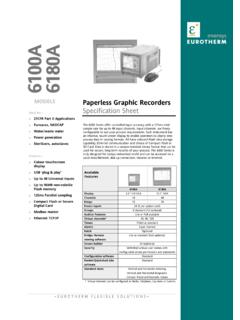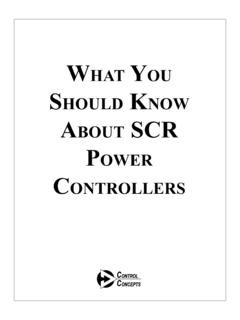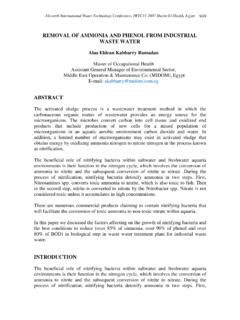Transcription of T4409 Issue 2 ENDOTHERMIC GENERATORS …
1 T4409 Issue 2. ENDOTHERMIC GENERATORS technical data T4409 . Issue 2. AN OVERVIEW OF ENDOTHERMIC GENERATORS . by Theodore P. Berry technical data The ENDOTHERMIC generator creates an atmosphere to provide a positive pressure in a heat treating furnace, and a platform on which a carburizing or decarburizing environment can be formulated, by addition of enriching gas or dilution air. Generator maintenance scheduling, operation, and control are discussed. INTRODUCTION. ENDOTHERMIC atmosphere, commonly called endo, carrier gas or Rx gas, is synthesized in the catalytic retort(s) of endo GENERATORS . This gas, combined with an additive gas such as natural gas or propane, or air, is used in heat treating furnaces to modify the surface chemistry of work positioned in the furnace. Other carrier gases such as exothermic gas, dissociated ammonia and other nitrogen based atmospheres are found in many heat treating facilities, but endo is most common.
2 Because endo can have a profound impact on the quality of processing, it is important to establish a preventive maintenance program for the generator, and then follow the program religiously. The most common source of endo is the reaction product of air and natural gas in ratios between about to 1 to to 1. Since the reaction is not spontaneous below ratios of 6 to 1, it is necessary to supply heat to the generator--- hence the term ENDOTHERMIC , meaning heat absorbing. Typical endogas GENERATORS produce an atmosphere of approximately 20% carbon monoxide, 40% hydrogen and 40% nitrogen, trace amounts of carbon dioxide and other gases originating in the natural gas or created by the reaction. The application of heat is not sufficient to create the desired products rapidly, so the reacting gases must be exposed to a catalytic agent to accelerate the reaction. Principal components of an endogas generator are: 1. a heating chamber to supply heat by combustion or electric heating elements, 2.
3 One or more cylindrical retorts (usually vertical) in the heating chamber with 3. numerous small, porous ceramic pieces, impregnated with nickel as a catalyst for the reaction. Also included as part of the generator is 4. a cooling heat exchanger to rapidly cool the reaction products to a temperature that will not allow the reaction to proceed further. One of the most critical parts of the system is 5. the control system that maintains the reaction temperature and adjusts the gas/air ratio to provide the desired dew point. MAINTENANCE SCHEDULE. Note: The maintenance schedule suggested in the following paragraphs has been culled from numerous "industry standards" as well as over twenty years of application experience of SSI. staff working with the equipment. Because of the make and design of your equipment, and your routine maintenance procedures, not all of these recommendations may apply. SUPER SYSTEMS technical data SHEET.
4 T4409 Issue 2. ENDOTHERMIC GENERATORS technical data Daily: 1. Visually examine all instrumentation to assure that operation is incident. Determine that control outputs are within the expected range of operation. 2. Check temperature of water discharged from heat exchanger. Weekly: 1. Regenerate ( burn out ) carbon in generator using air ( preferred method ), exothermic gas, or lean ENDOTHERMIC gas. 2. After regeneration and readjustment of generator to proper dew point, check the gas analysis ( including CH4 content) with an infrared analyzer if possible. 3. Clean the air filter. Monthly: 1. Clean air-gas mixing valve (carburetor ) thoroughly. 2. Check calibration of gas analysis and control equipment such as automatic dew point controllers, manual dew point indicators, CO/CO2 analyzers and oxygen probe carbon potential control systems. The primary standard for carbon analyzers is shim stock tests. Alnor or equivalent dew point testing gives a reasonable indication of correct operation.
5 3. Inspect thermocouples and protection tubes and replace every 3 to 4 months. 4. Check natural gas pressure after the regulator to maintance balance to the carburetor. 5. Verify correct operation of over temperature controls. Semi- annually: 1. Replace heat exchanger with standby, clean and refurbish for next service. 2. Inspect catalyst in retort and fill to proper level or replace. 3. Inspect and clean all burners. 4. Clean endo delivery lines to furnaces. 5. Inspect cooling water thermostats, solenoids. 6. Perform complete instrument calibration and service, including safety controls. 7. Have oxygen probe ( carbon sensor ) refurbished, inspected and certified. Annually: 1. Check compressor blades. 2. Check motor and compressor bearings. Additional Troubleshooting Considerations Problems at the furnace can alter an otherwise correct endo atmosphere due to air or water incursion. Therefore both the atmosphere manifold and the furnace should be checked carefully, when a problem is encountered, before attempting any corrective changes in the generator atmosphere control system.
6 Air Maintenance One of the major sources of difficulty, and hence a nagging maintenance problem, is poor quality air. Contaminants in the air can include dust, fumes from acid cleaning tanks and oil quenching SUPER SYSTEMS technical data SHEET. T4409 Issue 2. ENDOTHERMIC GENERATORS technical data systems. Airborne dust has been linked to failure of pumps and flowmeters, and poor electrical contact in relays. Combustible vapors can cause a carbon sensor to read low, resulting in over carburization. In order to maintain a good air quality, it is necessary to establish a routine for cleaning filters. In some cases it may be necessary to install ductwork to bring outside, contaminant free air to the equipment. Dust-tight electrical housings are sometimes necessary to eliminate dust and fume problems. Cooler Maintenance The design objective of coolers is to cool the generated atmosphere as quickly as possible to below about 2600F in order to stabilize the composition before being delivered to the furnace.
7 Two problems impact on operation of the water cooled heat exchanger. First, dissolved and suspended solids in the water will deposit and coat the tube walls, thereby reducing the heat transfer rate. Further, dissolved oxygen in the water can promote oxidation of the tubes, resulting in premature failure. Water cooled heat exchangers should be cleaned and pressure tested for leaks during catalyst replacement. Air cooled exchangers should be blown out with air or rodded as necessary also during catalyst replacement. Gas Supply For the successful operation of any gas generator, an adequate supply of gas of the proper composition is required at all times. Dirt, scale and water vapor can cause plugging and failure of regulators and control valves. Flowmeters are especially susceptible to dirt build-up on the float and walls. Gummy deposits from a poor gas mixture can also cause sticking of valve parts and carburetors. One of the most troublesome problems is the inconsistent analysis of the supply fuel.
8 Propane-air additives to natural gas supplies ('peak shaving') alter effective generator ratios. Unsaturated hydrocarbons such as ethylene and propylene break down quickly into oily soot or coke. Unfortunately, there is little choice when using utility-supplied natural gas. In some instances, propane is selected to avoid these problems, but is not always an economical solution. Sulfur, both naturally occurring and as additive mercaptans, can cause poisoning of the nickel catalyst and an ultimate failure of the generator to crack gas properly. It is therefore essential that the gas supply system be kept under close observation, and that all critical components of the system, such as those previously mentioned, be inspected and cleaned as required on a programmed basis. It may be advisable to inform your gas/utility supplier of your special concerns should they, at their discretion opt to alter your feedstock supply by "dosing" or "spiking" ( peak shaving) your gas.
9 We find, in many instances, that the gas utility companies will not advise you of this practice and are reluctant to discuss it. Maintenance of the Combustion System SUPER SYSTEMS technical data SHEET. T4409 Issue 2. ENDOTHERMIC GENERATORS technical data The maintenance of the combustion system of a gas fired ENDOTHERMIC generator is not different from other combustion systems; that is, it should be kept clean and adjusted. Most such systems are relatively simple. Electrical Maintenance A reliable, uniform supply of regulated power is necessary to operate relays and solenoid valves. Electrical problems are usually easy to spot, since maintenance personnel are well trained and have sufficient test equipment and wiring diagrams for trouble shooting. Thermocouples and Protection Tubes In most atmosphere GENERATORS , we recommend the use of type S thermocouples. Because of the relatively high temperatures maintained in atmosphere GENERATORS (1850oF to 1950oF), thermocouples should be inspected every three to four months, and replaced if found faulty.
10 Protection tubes and seal rings should be checked each time the thermocouples are replaced; a broken or leaking tube will greatly shorten the life of the thermocouple. If there is a substantial difference in indicated temperature between the control and overtemp instruments, it can very well be caused by deterioration of one of the protection tubes, causing early failure of the couple. If this should happen, check, and replace as necessary. It is often standard practice to replace the protection tubes when the thermocouple is replaced. Maintenance of Temperature Controls In addition to temperature controls, most atmosphere GENERATORS have an over temperature (high limit) instrument to shut the system down in the event of a runaway temperature. Because of the great variety of recorders, recorder/controllers and controllers, it is difficult to discuss exact inspection, calibration and repair procedures, but general rules of thumb apply.





